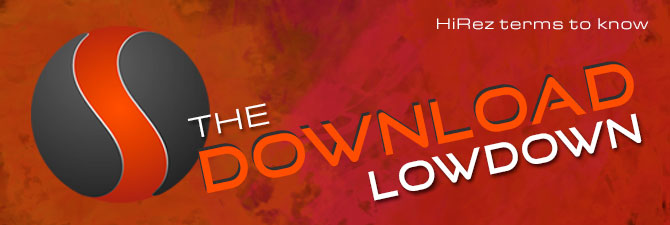Call it “high-resolution”, “high-res” or “hi-rez” — Refers to various kinds of high-definition audio files for downloading music. DSD — “Direct Stream Digital” — A system for digitizing music that is often compared with analog in terms of sound quality. The format used to produce Super Audio CDs. • DSD format captures sound as a one-bit sound wave sample, but it measures the sound wave 64 or 128 times the sampling rate of CD audio — either 2.8 MHz or 5.6 MHz. For some engineers this is the closest a digital file sample can get to an original analog source. The result is much more life-like quality than MP3 or CD. DSD is available as either 2-channel (traditional stereo) or multi-channel (surround sound) files. PCM — Pulse-code modulation— Traditionally the most common method used to digitally represent sampled audio. This method of audio conversion is the standard used by most digital audio formats, including CD, MP3 & AAC, DVD & DVD-Audio, and Blu-ray & Blu-ray Audio. • Multi-bit high-resolution audio files sport an identifying number sequence: 192-kHz/24-bit or 96-kHz/24-bit for example. The first number refers to how many times per second the sound wave is measured (sampled). The second is the number of bits of information in each sample. CDs use 16 bits sampled at 44.1kHz, but there is no single standard for high-resolution audio. • Hi-res PCM albums are also sold in a variety of playback formats including FLAC, ALAC, AIFF, WAV and others. The info in each is identical, but with FLAC and ALAC, the data (not the sound) is compressed so it takes up less space, similar to a Zip file. These “lossless” file types are designed to keep intact the audio quality of the original source. • DAC (Digital to Audio Converter) — A device capable, when connected via USB port or Firewire computer interface, of transfering files to play on analog stereo. DACs (depending on the type/number of inputs) can also connect to the digital output of audio devices — such as CD players, TVs, audio/video receivers, etc.) by a SPDIF or Toslink (optical) connection. • Media Servers — Home media servers give you the ability to pull up a piece of entertainment in a matter of seconds from various digital sources. A media server may be dedicated to just audio playback, for example, but others can play your personal home media library — music, as well as home movies and photos — from a compatible computer, smart phone, e-reader or other device. You can use these multi-function media devices for video sharing from YouTube, streaming music from Pandora and Spotify or sharing photos from your family vacation via Flickr and Facebook on your HDTV. The server options, capabilities and services offered are numerous, depending on the model. A Bit About Bits You'll note that many of our Super HiRez FLAC files are derivatives of a 44.1kHz base - i.e., 44kHz/24bit, 88kHz/24bit, 176kHz/24bit. That, instead of 96kHz/24bit or 192kHz/24bit. Please understand that the higher the number does not always mean the higher the quality. When we produce a FLAC file converted from a DSD master (which is not just acceptable but affords many sonic advantages), we choose to convert to a 44.1kHz base because it sounds better than converting to a 48kHz base. The reason is that the conversion math is simpler. In short, the 176kHz is going to sound better coming from DSD than would the 192kHz. The quality difference between 192k and 176k does not make up for that sonic advantage. So, rather than convert to a 48kHz base because the numbers will look more impressive, we've chosen to make the conversion that will actually sound the most impressive. Why FLAC? DSD is the only uncompressed format that we offer although we do not offer any formats that use lossy compression. We have not considered offering .WAV or .AIFF since .FLAC can be decompressed/converted to either .WAV or .AIFF bit-perfect with no loss, similar to encoding and decoding a .zip file. By having smaller downloads it saves download time, internet bandwidth, & hard drive storage space. We are aware of the controversy about quality differences with WAV/AIFF vs FLAC/ALAC lossless compression schemes but none of that makes a difference if you decode your FLAC files to WAV/AIFF. |
 In-Stock Music Orders Over $99 SHIP FREE Within The Continental U.S.
In-Stock Music Orders Over $99 SHIP FREE Within The Continental U.S.







 Login
Login
 My Account
My Account
 Cart
Cart Wishlist
Wishlist
 Contact
Contact





